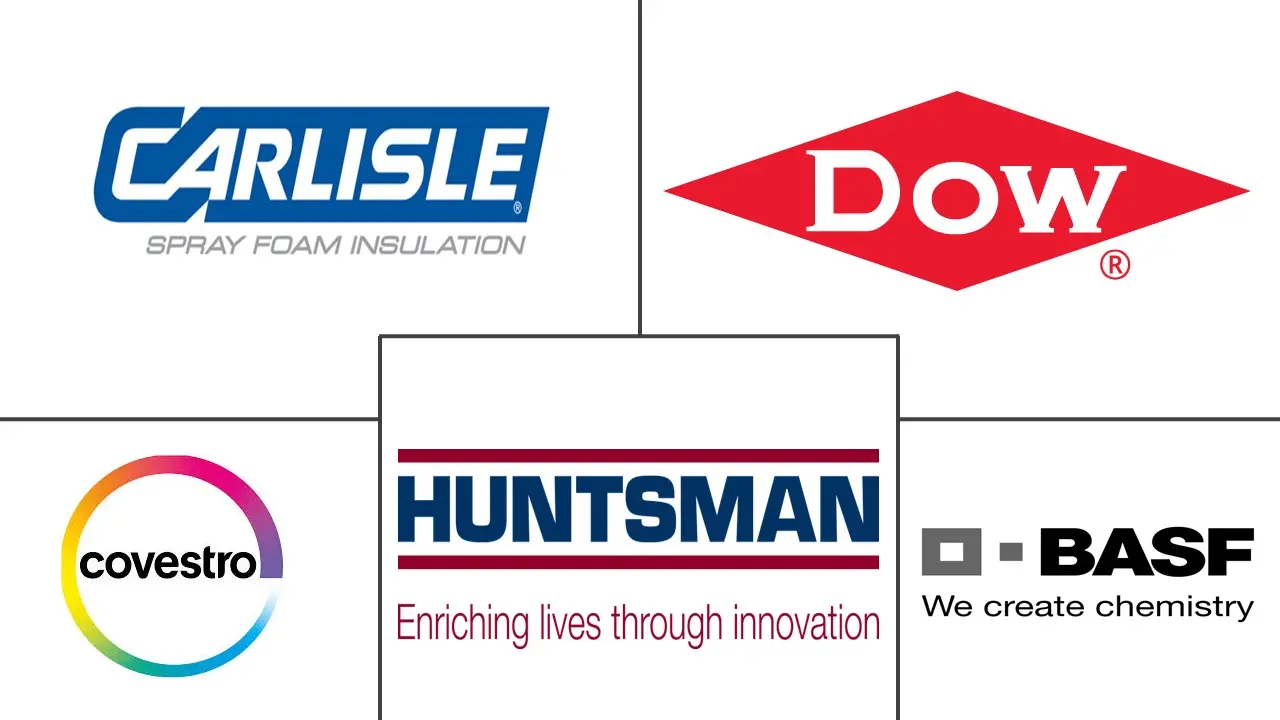Spray Polyurethane Foam Market Size and Share
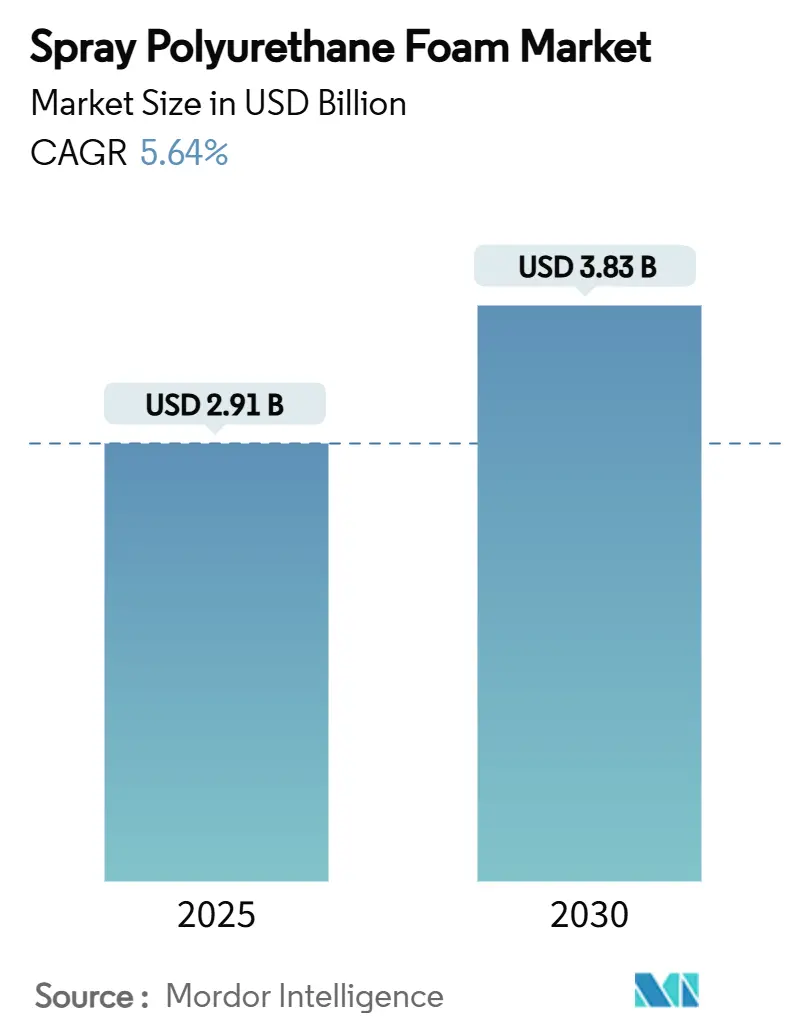
Spray Polyurethane Foam Market Analysis by Mordor Intelligence
The Spray Polyurethane Foam Market size is estimated at USD 2.91 billion in 2025, and is expected to reach USD 3.83 billion by 2030, at a CAGR of 5.64% during the forecast period (2025-2030). This expansion occurs as building-energy codes tighten, low-GWP regulations take effect, and cold-chain investment accelerates, driving higher-value insulation demand. Manufacturers are swapping high-GWP HFCs for hydrofluoroolefin and other next-generation blowing agents to comply with the EPA’s Technology Transitions Restrictions rule that began on 1 January 2025 epa.gov. Consolidation among installers, growing retrofit activity, and ESG-linked financing further reinforce momentum across residential, commercial, and industrial projects, while innovation in CO₂-based polyols positions suppliers for long-term sustainability gains.
Key Report Takeaways
- By product type, two-component high-pressure spray foam led with 37.62% of spray polyurethane foam market share in 2024, whereas semi-rigid spray foam is projected to grow at a 7.19% CAGR to 2030.
- By application, insulation commanded 39.18% of the spray polyurethane foam market size in 2024; concrete lifting and other specialty uses are expected to expand at 7.42% CAGR through 2030.
- By end-use industry, residential buildings accounted for 50.16% of the spray polyurethane foam market size in 2024, while industrial and infrastructure is advancing at a 7.85% CAGR to 2030.
- By geography, Asia-Pacific held 48.19% spray polyurethane foam market share in 2024 and is forecast to grow at 7.66% CAGR during 2025-2030.
Global Spray Polyurethane Foam Market Trends and Insights
Drivers Impact Analysis
| Driver | (~) % Impact on CAGR Forecast | Geographic Relevance | Impact Timeline |
|---|---|---|---|
| Strict building-energy codes and retrofit mandates | +1.2% | Global, with early adoption in North America and EU | Medium term (2-4 years) |
| Rising concerns over GHG emissions | +0.8% | Global, particularly APAC and North America | Long term (≥ 4 years) |
| Growth in cold-chain and refrigerated logistics | +0.6% | Global, with concentration in APAC and North America | Medium term (2-4 years) |
| ESG-linked "green bond" financing for SPF upgrades | +0.4% | North America and EU, expanding to APAC | Long term (≥ 4 years) |
| High-lift foam demand for solar-ready roofs | +0.3% | North America and EU, with emerging APAC adoption | Medium term (2-4 years) |
| Source: Mordor Intelligence | |||
Strict Building-Energy Codes and Retrofit Mandates
The 2024 International Energy Conservation Code elevates closed-cell spray foam as a preferred air-barrier solution, compelling architects to specify higher R-values and moisture control measures. California’s 2023 standards and Florida’s 2026 code update both streamline retrofit approvals, lowering removal costs and accelerating demand, particularly for low-slope commercial roofs[1].Florida Roof, “2026 Florida Building Code Updates,” floridaroof.com These rule changes widen the retrofit addressable base, encourage hybrid insulation assemblies, and push contractors toward more training and equipment investment that favors two-component systems.
Rising Concerns Over GHG Emissions
Corporate net-zero goals merge with building-owner cost targets, highlighting spray foam’s ability to cut heating-and-cooling energy by up to 10% according to the EPA’s Energy Star program. Installed Building Products reported a 55% CO₂ reduction from spray foam use since 2020 while materially increasing output, showing the technology’s decoupling of growth from emissions. Manufacturers such as Johns Manville logged double-digit drops in absolute emissions even as energy-saving product volumes rose, underscoring alignment between sustainability and profitability.
Growth in Cold-Chain and Refrigerated Logistics
Americold operates 239 facilities totaling 1.4 billion ft³ and holds 17.8% North American capacity share, illustrating how temperature-controlled warehouses create steady insulation demand. The Global Cold Chain Alliance’s 1,280-facility membership highlights global reach and growing need for high-performance, low-permeability insulation. Spray foam’s superior air-sealing delivers measurable energy savings in these power-intensive operations, reinforcing adoption across new builds and retrofits as e-commerce grocery delivery rises.
ESG-Linked Green-Bond Financing for SPF Upgrades
Capital markets increasingly tie funding costs to building-level carbon metrics, making spray foam retrofits eligible for lower-rate green bonds. HB Fuller’s work with CO₂-rich Converge polyols illustrates how material innovation attracts investors searching for verifiable emissions reductions. As LEED and BREEAM frameworks award points for airtightness and energy performance, owners monetize spray foam benefits through higher asset valuations and operating savings.
Restraints Impact Analysis
| Restraint | (~) % Impact on CAGR Forecast | Geographic Relevance | Impact Timeline |
|---|---|---|---|
| Competition from fiberglass and cellulose | -0.5% | Global, particularly North America residential | Short term (≤ 2 years) |
| Regulations and restrictions on di-isocyanates | -0.3% | Global, with stricter enforcement in EU and North America | Medium term (2-4 years) |
| HFO blowing-agent supply volatility | -0.2% | Global, with acute impact in North America | Short term (≤ 2 years) |
| Source: Mordor Intelligence | |||
Competition from Fiberglass and Cellulose
Cost-focused residential builders still default to fiberglass batts, supported by long-standing installer networks and low equipment requirements. Home Innovation Research Labs data showed an 11% to 8% pullback in spray foam share amid multifamily growth and material cost saving, highlighting price sensitivity. Fiberglass makers are narrowing performance gaps with higher-density offerings, while cellulose leverages recycled content branding to appeal to eco-minded consumers. Spray foam suppliers must therefore sharpen value messaging around lifecycle energy savings to overcome higher upfront spend.
Regulations and Restrictions on Di-Isocyanates
EU rules effective August 2023 compel contractor training for products containing more than 0.1% di-isocyanates, raising compliance costs and documentation burdens[2]European Chemicals Agency, “Restriction on Di-Isocyanates,” echa.europa.eu. The US EPA’s significant‐new-use regulation layers additional PPE and engineering-control mandates, particularly affecting smaller installers. While large manufacturers can embed training into distribution channels, cost impacts risk shifting demand toward emerging isocyanate-free chemistries, demanding ongoing R&D investment.
Segment Analysis
By Product Type: Two-Component Systems Drive Market Leadership
The segment anchored by two-component high-pressure systems held a 37.62% spray polyurethane foam market share in 2024, reflecting consistent on-site mixing, superior R-values, and code acceptance in commercial construction. BASF’s new isocyanate and TPU lines in Zhanjiang strengthen local supply chains, reinforcing the segment’s dominance in Asia-Pacific. Semi-rigid spray foam is expanding at a 7.19% CAGR as infrastructure projects need flexibility for vibration and temperature swings. One-component cans address small-project convenience, while low-pressure kits cover sensitive substrates where reduced exothermic heat is critical.
A push for integrated brands illustrates competitive strategy: Holcim’s Enverge® label merges Gaco™ and SES™ portfolios, giving installers a single specification path for roof, wall, and specialty foams. Product diversification frames cross-selling opportunities, with semi-rigid innovations aimed at solar-ready roofs and bridge decks, and intumescent-infused systems targeting fire-resistance regulations. Suppliers that maintain broad catalogs and regional technical centers remain best positioned to seize specification wins.
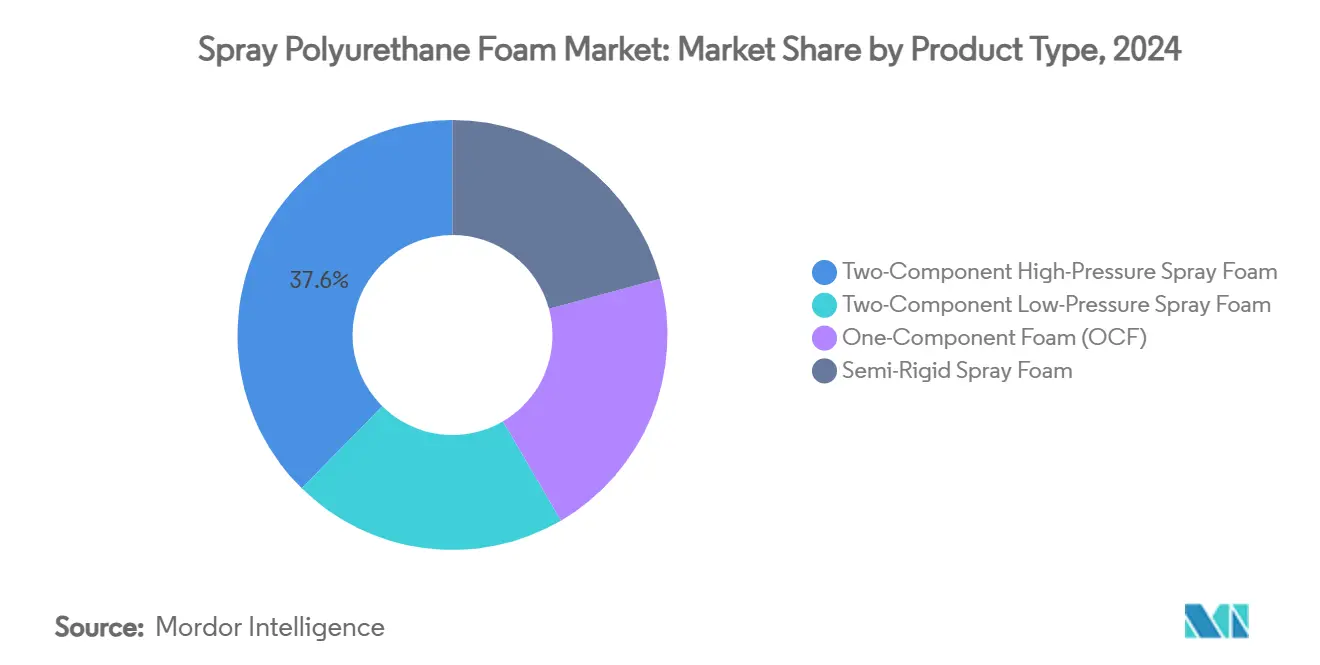
Note: Segment shares of all individual segments available upon report purchase
By Application: Insulation Dominance Faces Emerging Diversification
Insulation accounted for 39.18% of the spray polyurethane foam market size in 2024 and benefits from its dual role as air barrier under the 2024 IECC, which elevates whole-building airtightness requirements. In refrigerated warehouses, closed-cell formulations routinely deliver energy payback periods under four years, reinforcing specification in cold-chain projects. Concrete lifting, void filling, and geotechnical stabilization represent the fastest-growing “other applications” bucket, advancing at 7.42% CAGR as infrastructure spending catches up with deferred maintenance.
Waterproofing demand grows in podium-deck and green-roof designs where continuous membranes protect occupied space below. Sealants capitalize on spray foam’s self-adhering expansion, reducing thermal bridges around fenestration openings. Intumescent-embedded products like NCFI’s Staycell ONE STEP foam remove the need for separate thermal barriers, saving labor and satisfying NFPA 286 fire testing protocols. Diversified usage insulates the spray polyurethane foam market from cyclical new-build cycles by opening revenue in maintenance and infrastructure segments.
By End-use Industry: Residential Leadership Meets Industrial Growth
Residential buildings retained a 50.16% spray polyurethane foam market size share in 2024 thanks to rising energy-efficient home standards and homeowner awareness of lifetime utility savings. Tax incentives under IRA Section 25C reimburse up to 30% of envelope upgrades, stimulating retrofit volumes. Industrial and infrastructure projects, growing at 7.85% CAGR, anchor new capacity for cold-storage, food processing, and distribution centers; Americold’s 1.4 billion ft³ portfolio underscores this structural demand.
Commercial buildings offer steady institutional demand as offices and hospitals adopt tighter envelope requirements. Specialty agriculture and greenhouse facilities rely on closed-cell foam for condensation control and bio-security, while transport infrastructure adopts spray foam for sound damping and vibration isolation. Consolidation moves, such as TopBuild’s USD 39 million Texas Insulation purchase, give national installers leverage to serve multiple end markets with unified safety and quality‐control protocols.
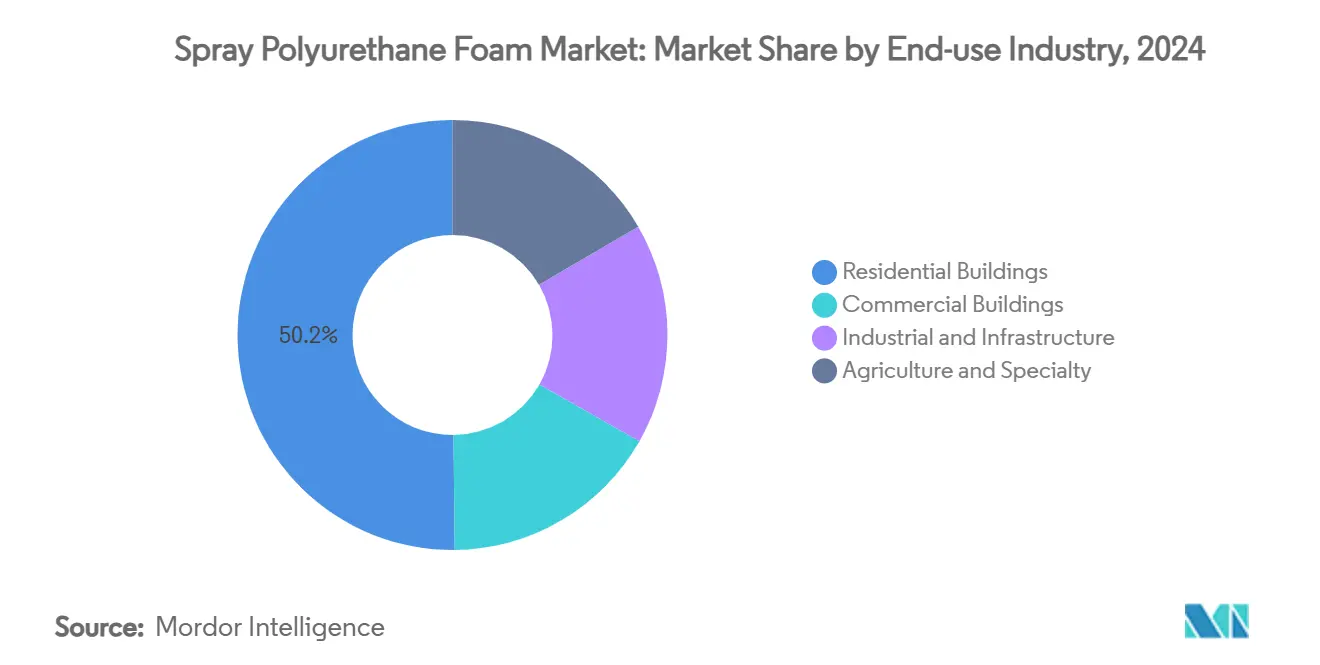
Note: Segment shares of all individual segments available upon report purchase
Geography Analysis
Asia-Pacific captured 48.19% of spray polyurethane foam market share in 2024 and is forecast to climb at 7.66% CAGR, driven by rapid urbanization, factory expansions, and energy-code adoption. China’s real-estate slowdown redirects stimulus toward urban renewal, boosting retrofit insulation spend, while India’s HVAC sector is set to hit USD 30 billion by 2030 on a 15.8% CAGR pathway, raising demand for building envelope upgrades. Japan and South Korea enforce stringent envelope requirements in seismic zones, favoring lightweight, high-adhesion insulation such as spray foam. ASEAN nations expand cold-chain capacity for seafood and vaccine storage, pulling regional demand upward. BASF’s multi-year USD 19.5 billion Asia-Pacific investment plan exemplifies supplier confidence in the region’s absorption capacity.
North America remains a mature but stable arena where federal HFC phase-outs harmonize compliance and keep specification complexity low. Canada’s cold climates sustain thick-layer attic spray foam usage, while Mexico emerges as the world’s fourth-largest polyurethane consumer on near-shoring momentum and automotive manufacturing growth. Consolidation among contractors enables national builders to standardize envelope solutions across the US and Canada, reinforced by TopBuild’s network expansion.
Europe’s net-zero directives and renovation wave stimulate demand despite tepid macro-economics. Di-isocyanate training rules introduce friction but ultimately favor well-capitalized manufacturers with robust EHS programs. Covestro’s DreamResource project introduces rigid foam containing 20% CO₂ as feedstock, demonstrating European leadership in circular chemistry. University of Liège advances isocyanate-free foams with 70-90% biobased content, underscoring regional academic–industry collaboration. In South America and the Middle East and Africa, energy-efficiency codes are tightening gradually; early movers in Brazil, Saudi Arabia, and the UAE adopt spray foam in commercial megaprojects, signaling future volume uplift.

Competitive Landscape
Fragmentation characterizes the spray polyurethane foam market as only 19% of commercial contractors currently offer SPF services, yet 67% of those firms improved sales from 2023 to 2024. The installer gap incentivizes roll-ups and private equity involvement—evident in Accella’s takeover of Quadrant’s spray unit and TopBuild’s regional tuck-ins—that aim to secure geographic coverage and trained labor. Large chemical companies including BASF, Covestro, Dow, and Huntsman compete on upstream integration, proprietary blowing-agent blends, and technical training programs, allowing them to guard share against regional formulators.
Sustainability is now an overt differentiator. Huntsman’s Building Solutions division converts PET bottles into polyurethane, aligning with circular-economy messaging that resonates with green-bond investors. Covestro and BASF commercialize CO₂-based polyols, while smaller innovators pursue isocyanate-free paths to pre-empt future toxicology regulation. Technology packages that include digital yield-tracking sprayers and cloud-based QA portals further separate premium suppliers from commodity blenders by reducing job-site waste and providing verifiable performance data to building owners.
Regional dynamics affect strategy. In Asia-Pacific, multinational suppliers localize output to avoid tariffs and reduce shipping times, while domestic producers leverage price to win commodity housing projects. North American players focus on code compliance and low-GWP composition, whereas European companies invest in biobased content and circular feedstocks. Across all regions, supplier collaborations with universities and additive companies accelerate product differentiation in flame retardancy, acoustics, and weatherability.
Spray Polyurethane Foam Industry Leaders
-
BASF SE
-
Dow Chemical Company
-
Huntsman Corporation
-
Covestro AG
-
Carlisle Companies Inc. (CSFI)
- *Disclaimer: Major Players sorted in no particular order
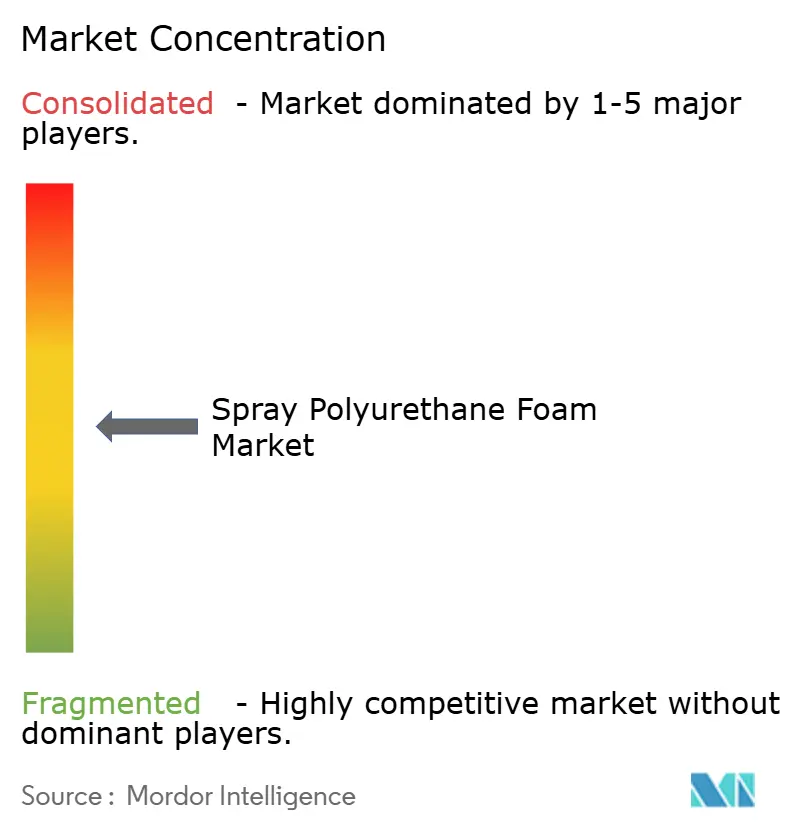


Recent Industry Developments
- January 2025: Accella Performance Materials has acquired Spray Foam Division of Quadrant Urethane Technologies. This move strengthens Accella’s position as leading spray polyurethane foam provider and expands its product range by integrating the new division with its current operations.
- January 2024: NCFI Polyurethanes announced that its Staycell ONE STEP 502 Intumescent Spray Foam has been approved as a code-compliant thermal barrier. This approval applies to their InsulStar Smart Spray Polyurethane Foam and InsulBloc Smart Spray Polyurethane Foam HFO products.
Global Spray Polyurethane Foam Market Report Scope
Spray polyurethane foam (SPF) is a spray-applied material frequently used to insulate buildings and repair cracks and gaps, resulting in a more energy-efficient and safe structure. The spray polyurethane foam market is segmented by product type, application, and geography. By product type, the market is segmented into two-component high-pressure spray foam, two-component low-pressure spray foam, one-component foam (OCF), and other product types. By application, the market is segmented into insulation, waterproofing, asbestos encapsulation, sealant, and other applications. The report also covers the market size and forecasts in 15 countries across major regions. For each segment, market sizing and forecasts have been done based on revenue (USD million).
| Two-Component High-Pressure Spray Foam |
| Two-Component Low-Pressure Spray Foam |
| One-Component Foam (OCF) |
| Semi-Rigid Spray Foam |
| Insulation |
| Waterproofing |
| Asbestos Encapsulation |
| Sealant |
| Other Application (Concrete Lifting / Void Filling, etc.) |
| Residential Buildings |
| Commercial Buildings |
| Industrial and Infrastructure |
| Agriculture and Specialty |
| Asia-Pacific | China |
| Japan | |
| India | |
| South Korea | |
| ASEAN Countries | |
| Rest of Asia-Pacific | |
| North America | United States |
| Canada | |
| Mexico | |
| Europe | Germany |
| United Kingdom | |
| France | |
| Italy | |
| Spain | |
| Russia | |
| NORDIC Countries | |
| Rest of Europe | |
| South America | Brazil |
| Argentina | |
| Rest of South America | |
| Middle East and Africa | Saudi Arabia |
| South Africa | |
| Rest of Middle East and Africa |
| By Product Type | Two-Component High-Pressure Spray Foam | |
| Two-Component Low-Pressure Spray Foam | ||
| One-Component Foam (OCF) | ||
| Semi-Rigid Spray Foam | ||
| By Application | Insulation | |
| Waterproofing | ||
| Asbestos Encapsulation | ||
| Sealant | ||
| Other Application (Concrete Lifting / Void Filling, etc.) | ||
| By End-use Industry | Residential Buildings | |
| Commercial Buildings | ||
| Industrial and Infrastructure | ||
| Agriculture and Specialty | ||
| By Geography | Asia-Pacific | China |
| Japan | ||
| India | ||
| South Korea | ||
| ASEAN Countries | ||
| Rest of Asia-Pacific | ||
| North America | United States | |
| Canada | ||
| Mexico | ||
| Europe | Germany | |
| United Kingdom | ||
| France | ||
| Italy | ||
| Spain | ||
| Russia | ||
| NORDIC Countries | ||
| Rest of Europe | ||
| South America | Brazil | |
| Argentina | ||
| Rest of South America | ||
| Middle East and Africa | Saudi Arabia | |
| South Africa | ||
| Rest of Middle East and Africa | ||


Key Questions Answered in the Report
What is the current value of the spray polyurethane foam market?
The spray polyurethane foam market size is USD 2.91 billion in 2025 and is projected to climb to USD 3.83 billion by 2030 at a 5.64% CAGR.
Which region leads the spray polyurethane foam market?
Asia-Pacific holds 48.19% market share in 2024 and is also the fastest-growing region with a 7.66% CAGR through 2030.
Which product segment dominates sales?
Two-component high-pressure systems lead with 37.62% market share in 2024 due to their strong R-value performance and contractor familiarity.
What factor most accelerates spray foam demand?
Tightening building-energy codes worldwide drive adoption because closed-cell spray foam provides simultaneous insulation and air-barrier performance.
How are suppliers addressing environmental regulations?
Leading manufacturers are shifting to low-GWP blowing agents, investing in CO₂-based polyols, and developing isocyanate-free chemistries to comply with emerging regulatory frameworks.
Page last updated on:
